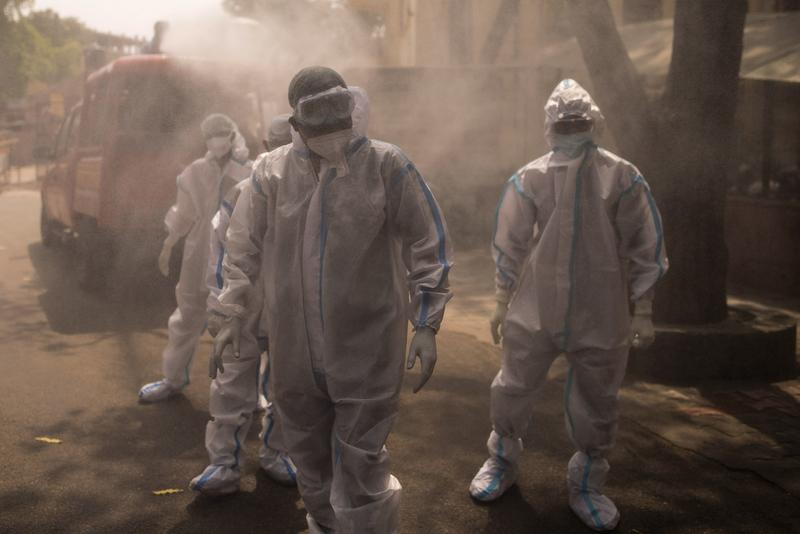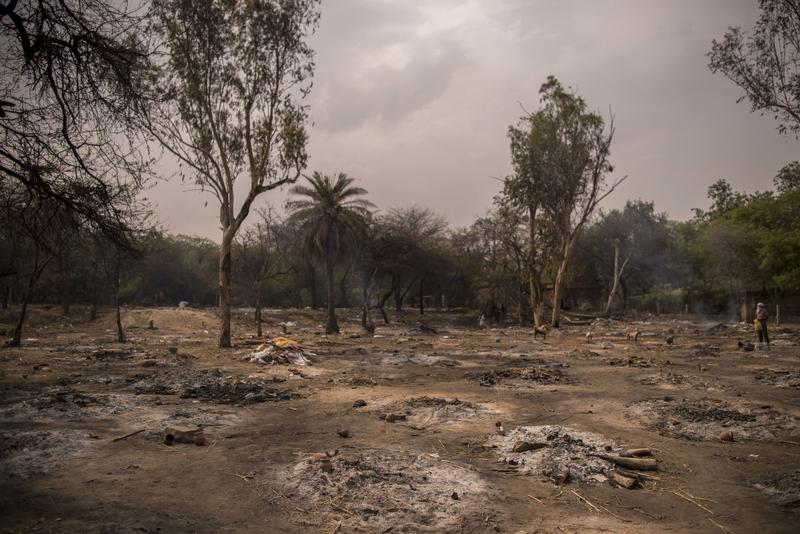 Frontline workers are sprayed with disinfectant at a COVID-19 Care Center set up at the Sarojini Naidu Medical College (SNMC) in Agra, Uttar Pradesh, India, on Monday, May 3, 2021. (ANINDITO MUKHERJEE / BLOOMBERG)
Frontline workers are sprayed with disinfectant at a COVID-19 Care Center set up at the Sarojini Naidu Medical College (SNMC) in Agra, Uttar Pradesh, India, on Monday, May 3, 2021. (ANINDITO MUKHERJEE / BLOOMBERG)
Two weeks ago, Indian Prime Minister Narendra Modi called on states to only consider lockdowns “as the last option.” Now everyone from his political allies to top business leaders and US President Joe Biden’s chief medical adviser see them as the only way to stem the world’s worst virus outbreak.
One of the problems is this false narrative that it’s either a full lockdown, which equates to economic disaster, or no lockdown, which is a public health disaster ... What’s happening now is a health and an economic disaster. If you have huge swaths of your population getting sick, that’s not good for your population or your economy.
Catherine Blish, infectious disease specialist and global health expert at Stanford Medicine in California
The debate has been complicated by Modi’s move last year to impose a nationwide lockdown without warning, spurring a humanitarian crisis as migrant workers fled on foot to rural areas. While Modi is keen to avoid that criticism again, particularly after his Bharatiya Janata Party failed to win an election in West Bengal when votes were counted Sunday, even states run by his party are ignoring his advice.
“One of the problems is this false narrative that it’s either a full lockdown, which equates to economic disaster, or no lockdown, which is a public health disaster,” said Catherine Blish, an infectious disease specialist and global health expert at Stanford Medicine in California. “What’s happening now is a health and an economic disaster. If you have huge swaths of your population getting sick, that’s not good for your population or your economy.”
In the past week, television channels and social media have been flooded with grim scenes of overcrowded crematoriums and desperate pleas for oxygen from hospitals. On Tuesday, the country reported more than 357,000 new infections to cross 20 million cases, as well as 3,449 deaths.
The Indian rupee has turned into Asia’s worst-performing currency this quarter from being the best in the previous quarter as foreigners pulled about US$1.8 billion from the nation’s stocks and bonds. The benchmark S&P BSE Sensex Index declined about 1.5 percent as investors turned cautious amid the deadly outbreak.
India’s richest banker Uday Kotak, who heads the Confederation of Indian Industry, urged the government to deploy the military to help care for patients and to take the “strongest national steps including curtailing economic activity to reduce suffering.” “We must heed expert advice on this subject - from India and abroad,” he said.
ALSO READ: It's not just India: New virus waves hit developing nations
This represents a shift from India’s top business leaders. In April, a survey of the confederation’s members showed they were against lockdowns and wanted swift vaccination. In the past month however, the collapsing health infrastructure and mounting death toll has revealed the extent the crisis. A lack of adequate vaccine doses has only added to the chaos.
 A relative collects the ashes of a COVID-19 fatality a day after performing the last rites at a crematorium in Agra, Uttar Pradesh, India, on Monday, May 3, 2021. (ANINDITO MUKHERJEE / BLOOMBERG)
A relative collects the ashes of a COVID-19 fatality a day after performing the last rites at a crematorium in Agra, Uttar Pradesh, India, on Monday, May 3, 2021. (ANINDITO MUKHERJEE / BLOOMBERG)
Reasoned lockdowns
Although policy makers have signaled they are ready to take steps to support growth, economists say a failure to flatten the virus curve could exert pressure on monetary and fiscal policies at a time when most of the conventional space available has already been used.
Instead of a strict shutdown, experts said, local governments could stop activities where it is difficult to maintain social distancing
The most immediately effective way to break the chain of transmission is to keep people far enough apart that the virus can’t jump from one to another. Some experts, including Anthony S. Fauci, the top US infectious disease doctor, say a temporary shut down is important.
But others say complete national lockdown isn’t possible and would be disastrous for the poor, who have already suffered the most during the outbreak. The federal government has left it open for states to decide on local lockdowns, and places like the national capital Delhi and the financial hub Mumbai have imposed restrictions - though they are less strict than last year.
People who live hand-to-mouth must go out every day to find something to eat or earn a day’s wages, said Kim Mulholland, an Australian pediatrician and leader of the infection and immunity group at the Murdoch Children’s Research Institute in Melbourne.
As hospitals struggle for oxygen and bodies pile up at crematoriums, a blanket lockdown may only add to the misery. A sudden loss of livelihoods may once again prompt a rush of workers from cities to their home towns and villages, also helping the virus spread to the hinterlands.
Instead of a strict shutdown, experts said, local governments could stop activities where it is difficult to maintain social distancing.
READ MORE: India's COVID-19 cases at 20m, peak called near
“I would absolutely curtail indoor retail, restaurants, shops, as much as possible anything that has people getting together indoors,” said Ashish Jha, the dean of Brown University School of Public Health. “I would absolutely ban any large congregations outside, though it’s hard in places in India where things can get pretty crowded naturally.”


